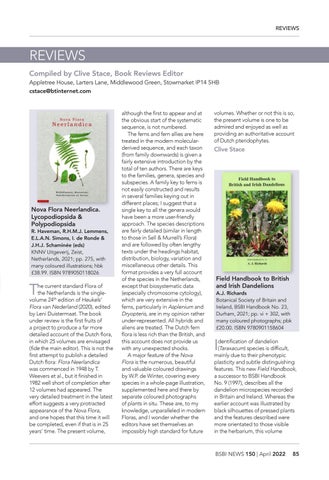REVIEWS
REVIEWS Compiled by Clive Stace, Book Reviews Editor
Appletree House, Larters Lane, Middlewood Green, Stowmarket IP14 5HB cstace@btinternet.com
Nova Flora Neerlandica. Lycopodiopsida & Polypodiopsida
R. Haveman, R.H.M.J. Lemmens, E.L.A.N. Simons, I. de Ronde & J.H.J. Schaminée (eds) KNNV Uitgeverij, Zeist, Netherlands, 2021; pp. 275, with many coloured illustrations; hbk £38.99. ISBN 9789050118026
T
he current standard Flora of the Netherlands is the singlevolume 24th edition of Heukels’ Flora van Nederland (2020), edited by Leni Duistermaat. The book under review is the first fruits of a project to produce a far more detailed account of the Dutch flora, in which 25 volumes are envisaged (fide the main editor). This is not the first attempt to publish a detailed Dutch flora: Flora Neerlandica was commenced in 1948 by T. Weevers et al., but it finished in 1982 well short of completion after 12 volumes had appeared. The very detailed treatment in the latest effort suggests a very protracted appearance of the Nova Flora, and one hopes that this time it will be completed, even if that is in 25 years’ time. The present volume,
although the first to appear and at the obvious start of the systematic sequence, is not numbered. The ferns and fern allies are here treated in the modern molecularderived sequence, and each taxon (from family downwards) is given a fairly extensive introduction by the total of ten authors. There are keys to the families, genera, species and subspecies. A family key to ferns is not easily constructed and results in several families keying out in different places; I suggest that a single key to all the genera would have been a more user-friendly approach. The species descriptions are fairly detailed (similar in length to those in Sell & Murrell’s Flora) and are followed by often lengthy texts under the headings habitat, distribution, biology, variation and miscellaneous other details. This format provides a very full account of the species in the Netherlands, except that biosystematic data (especially chromosome cytology), which are very extensive in the ferns, particularly in Asplenium and Dryopteris, are in my opinion rather under-represented. All hybrids and aliens are treated. The Dutch fern flora is less rich than the British, and this account does not provide us with any unexpected shocks. A major feature of the Nova Flora is the numerous, beautiful and valuable coloured drawings by W.P. de Winter, covering every species in a whole-page illustration, supplemented here and there by separate coloured photographs of plants in situ. These are, to my knowledge, unparalleled in modern Floras, and I wonder whether the editors have set themselves an impossibly high standard for future
volumes. Whether or not this is so, the present volume is one to be admired and enjoyed as well as providing an authoritative account of Dutch pteridophytes.
Clive Stace
Field Handbook to British and Irish Dandelions
A.J. Richards Botanical Society of Britain and Ireland, BSBI Handbook No. 23, Durham, 2021; pp. vi + 302, with many coloured photographs; pbk £20.00. ISBN 9780901158604
I
dentification of dandelion (Taraxacum) species is difficult, mainly due to their phenotypic plasticity and subtle distinguishing features. This new Field Handbook, a successor to BSBI Handbook No. 9 (1997), describes all the dandelion microspecies recorded in Britain and Ireland. Whereas the earlier account was illustrated by black silhouettes of pressed plants and the features described were more orientated to those visible in the herbarium, this volume
BSBI NEWS 150 | April 2022
85


